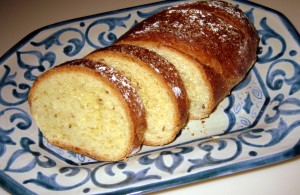 After three preliminary batches from several sources I finally chose Joyce Goldstein’s recipe in her SAFFRON SHORES as my starting point for this dense, flavorful bread, brought to France by Algerian Jews. After three more times I simplified the method by eliminating her preliminary sponge and altering the ingredients slightly. Some recipes for mouna include jam in the middle of the loaf. I like to buy my anise and sesame seeds from the bulk foods in the grocery store. Sesame is usually with the nuts and grains, while anise can be found where bulk spices and teas are displayed.
After three preliminary batches from several sources I finally chose Joyce Goldstein’s recipe in her SAFFRON SHORES as my starting point for this dense, flavorful bread, brought to France by Algerian Jews. After three more times I simplified the method by eliminating her preliminary sponge and altering the ingredients slightly. Some recipes for mouna include jam in the middle of the loaf. I like to buy my anise and sesame seeds from the bulk foods in the grocery store. Sesame is usually with the nuts and grains, while anise can be found where bulk spices and teas are displayed.
Dry ingredients:
3 1/2 C all-purpose flour
2 tsp salt
1 envelope quick-acting yeast
(or 2 1/4 tsp instant yeast)
1/2 C sugar
grated zest of one large orange
2 TBSP sesame seeds
2 TBSP aniseeds
Wet ingredients:
1/2 C warm water (no more than 130° F)
3 eggs (room temperature), beaten *
3 TBSP canola oil
3 TBSP melted unsalted butter
* To bring eggs to room temperature, place in a bowl of very warm water for a few minutes. Do not leave them sitting out of refrigerator for a long time.
Glaze and topping:
1 egg yolk mixed with 3 TBSP water
Confectioners’ sugar and/or pearl sugar
Place dry ingredients in bowl of stand mixer and whisk by hand to combine them. Place bowl on mixer stand and attach dough hook. Combine the liquid ingredients in a large measuring cup with a pouring lip. With machine running at low speed, gradually add the liquid mixture to the bowl. Once all has been added, run mixer on medium-low until dough is homogeneous and smooth. It may be slightly sticky, but it should easily come away from hands and sides of bowl. If after four minutes the dough is still very sticky, add up to 1/2 C of flour, 2 TBSP at a time, mixing in well with the hook.
Remove dough from mixer and knead briefly by hand to assure that it is smooth throughout. (Using a dough scraper to lift the dough from the counter initially can make this easier.) Form a ball and place in a Ziplok bag; press out the air and seal the bag. Leave on counter until dough doubles, about 1 hour (indentation made with a fingertip in side of the dough will remain.) AT THIS POINT YOU CAN REFRIGERATE THE DOUGH FOR SEVERAL HOURS OR OVERNIGHT. It won’t rise much and you can continue later after allowing the dough to return to room temperature in its bag on the kitchen counter.
Cover a baking sheet with lightly floured parchment or a silicone liner. Divide the dough into 4 equal portions and shape into cylinders and/or rounds. Place on the prepared baking sheet. Cover with plastic wrap or the inverted bottom of a large rectangular plastic storage box. Again let rise until double. (This may take a couple of hours, but requires no hands-on effort from the baker!) Preheat oven to 350° (325° convection) and place rack at the middle level of the oven. Prepare the egg yolk glaze.
When loaves have doubled, slash their tops in several places with a razor blade or sharp knife. Brush with the diluted egg yolk. Dust loaves lightly with confectioners’ sugar. Place in oven for 30 to 40 minutes, turning the baking sheet after 15 minutes to assure even coloring. Test for doneness by listening for a resonant sound when tapping a loaf on the bottom, or use an instant-read thermometer to check for a temperature of 190 -200 degrees. Cool the loaves on a rack before cutting them. This makes great toast!
See where Larry and I found mouna for sale in Paris last year at Du Pain et Des Idées, a bakery whose name translates as “Some Bread and Some Ideas.” I had made the bread sight unseen and taste untasted and we were delighted to find how close I’d come to the bakery version. We were surprised to find that this was not identified as a Jewish loaf until the young woman at the cash register was eager to tell us more about it. More of our album with bakery photos here.

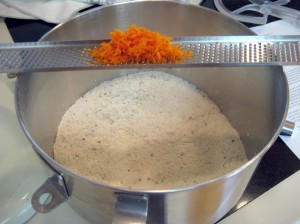
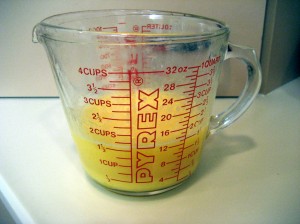
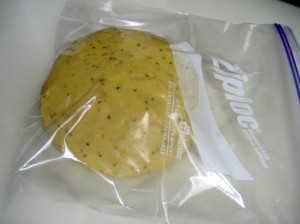
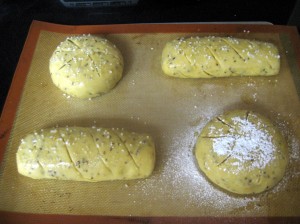
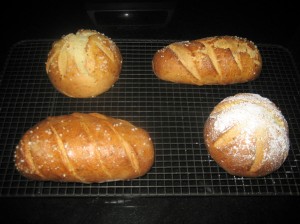

ITS VERY GOOD BREAD I WILL TRY IT